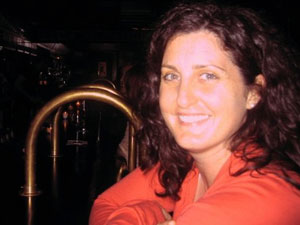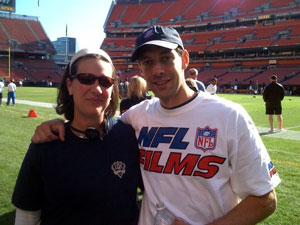"This is what’s really cool about NFL Films" - An Interview with Margaret Ruffing Morris
By Jennifer Porst
Margaret Ruffing Morris grew up in Port Huron, Michigan, with absolutely no allegiance to the Detroit Lions beyond indulging in a turkey hotdog or two during the Thanksgiving Day games in the mid-1980’s. She spent her freshmen year of college at Loyola University Chicago before transferring to the University of Notre Dame where she graduated with honors and earned a BA, majoring in Film and Philosophy. She is currently an Emmy Award winning Senior Producer at NFL Films and resides in Riverton, NJ with her husband and three year-old son.
Jennifer Porst, PhD student in UCLA’s Cinema and Media Studies and Co-Editor-in-Chief of Mediascape, studied film with Margaret at Notre Dame, and when “Columns” decided to take up sports as their theme for this issue, Jennifer jumped at the opportunity to talk with her friend a bit more about her work with NFL Films.
Jennifer Porst: Would you talk a little bit about NFL Films and who you are and what you do?
Margaret Ruffing Morris: Well, NFL Films is actually kind of an arm of the NFL. Ed Sabol started it in 1962, and he wanted to make movies – use a film camera and make a movie out of football games. His son, Steve Sabol runs it now. Ed actually contacted Pete Rozelle who was the NFL Commissioner at the time, and bid the rights to get to film NFL games. From there we started out being Blair Motion Pictures, and then the NFL decided this is a pretty powerful little machine you’ve got going on down there and we kind of were swallowed up by the NFL. Now we shoot film cameras at every football game every weekend and we do all of our production in house, from going out and shooting it to bringing it back, and we have a lab and telecine transfer. Everything is contained right here. We have a staff of about 70 producers, and we do shows for ESPN, ABC, CBS, HBO, Showtime, NFL Network, NFL.com, Fox, TruTV…. We’re kind of our own little production house.
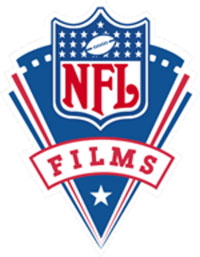
JP: When you say that you shoot film at the games, is it 16mm or 35mm or both?
MRM: 16mm film. We have a ground camera, a slow motion ground camera, and a top camera and different cinematographers shoot different speeds. We have some guys who can shoot 120 frames per second because we’re getting that tight on the spiral shot that NFL Films is kind of known for. And now we have a lot more sync sound cameras at all the games just because of the need for all the programming. You see our film on all of… we’re kind of everywhere now. When NFL Films began, it was like the romantic Hollywood style slow motion with the symphonic music and Jon Facenda’s voice and all the classic lines were sort of just signature NFL Films, and now we’re on every Sports Center and NFL Network and everywhere.
JP: Do ABC, NBC, and CBS use your footage for their sports shows too?
MRM: They do. Basically, we have all these major contracts, so everything we shoot, all of those networks do have access to it, and you will see it in their shows.
JP: Are you owned by the NFL?
MRM: Yes, we are. We’re basically just as much owned by the owners as the teams. My handbook is the NFL employee handbook. We are owned by the NFL, but we are able to operate autonomously. The NFL has been good enough to basically leave us alone down here in southern New Jersey to do what we do best and the Sabols, Ed and Steve, have been wise to keep us here doing just that.
JP: Then I would guess the NFL wouldn’t let other people in to shoot their games, so do you have exclusive access to shoot their games?
MRM: We do not. No. That’s just because professional football is the most popular sport in the country. No, NFL Films, we’re the arm of the league.
JP: So, when you’re watching a game on NBC or whatever channel on the weekend, the live footage that we’re seeing is network footage?
MRM: The NFL has contracts with NBC, CBS, Fox, whoever, for the live games, so there are network cameras at every game. That’s what you’re seeing on TV. Everything that we shoot is in film. We are the guys who are out there on Sunday shooting, we come back, and it takes obviously a couple days to process, transfer, and then you’ll see our stuff. Inside the NFL used to be the longest running cable show on HBO, last year it was on Showtime, but that’s really the premiere essentially of all the film that we shoot at the games. It airs on Inside the NFL, and then you’ll start to see it on ESPN. We always think, “Oh well, people don’t know the difference,” but people in the industry, you can tell the difference between film and video mostly because of the slow motion and the depth and everything else.
JP: Can you tell me about how you ended up at NFL Films?
MRM: I ended up at NFL Films because they came on a recruiting trip to Notre Dame, and I did not have any real job prospects being a film and philosophy major [laughs], and I saw the name NFL Films, and I had actually never heard of them as terrible as that sounds, but I didn’t grow up in a football family. So, I was like, “Films, I’m a film major, let’s do that,” and I interviewed with them, and low and behold I was offered an associate producer position right out of college, and so I came and I started out as an associate producer.
JP: What were you doing as an associate producer?
MRM: At that time, a lot of research and digitizing. Specifically, that was during “Feel the Power.” I was assigned to work with a producer who was doing the “Feel the Power” spots for the league, and so I was researching shots for them and we also started cutting segments for an international show we did called Blast, and slowly I started editing a little bit more and working on the Avid and doing segments with writing, and then I was cutting, editing and writing segments for a show called NFL Under the Helmet on Fox which started in 1999, and that is pretty much the show I worked on until 2005.
JP: Then what were you doing?
MRM: The title “producer” here, it’s really segment producer because we have complete creative control over everything that we do. When I was working on Under the Helmet as a segment producer, we’d have our staff meetings, and from conceptualizing ideas in our meetings then we’d go out and we’d shoot them, and I was directing and traveling a lot, and directing these shoots, I’d say, “Oh, I heard Jake Plummer is into mountain biking,” so I’d fly down to Arizona, spend two days with Jake Plummer, shoot all this awesome film footage, slow motion of him mountain biking with the cactus, and then do an interview with him and then I’d come back, and I’d edit it and then write the copy for it. Lay down music, and see it all the way through post-production. So, that’s kind of a sidebar about just being a producer here is that you do pretty much everything.
Then I became show head of Under the Helmet. Which, here we have show heads. All of the different shows that we do, a producer is assigned to be the show head and that person oversees all aspects – all the other segment producers. Then, if there is a studio portion to the show, you have to shoot the studio part, and you pretty much have the last say I guess - kind of stylistically, the writing, and I love that [laughs]. Under the Helmet was kind of our teen show, based in music and football, and in between there of course we do highlight films, and I’ve always worked a little bit on Inside the NFL, which is our game recaps that we did for HBO and now Showtime, and we do a series for the NFL Network. I worked on a series called Top 10, which everybody does the top ten shows now, the list style shows are very popular. NFL Films Presents, which is more like the stories, historical stories.
“Top Ten – Bad Weather Games.”
Segment produced by Ruffing Morris for the NFL Network’s Top Ten.
JP: Is this all stuff that you’re still doing now?
MRM: For the most part. This is what’s really cool about NFL Films, is that we do so many different things that in between doing Under the Helmet, in the off-season I directed a couple 35mm commercial shoots, football spots, NFL Shop spots, and we also have outside clients here too, so some of the stronger directors actually kind of get contracted out when outside clients come in and say, “We want you to shoot our Nokia commercial.” So, then you can go out and track that as well.
JP: What kind of outside clients come in?
MRM: Last year we had Audi come in, and they wanted a documentary on Le Mans, the car race, and we actually did a two hour documentary film for Audi. They were a big client.
JP: Is it mostly different corporations who are looking for something sports related?
MRM: No, it’s not necessarily sports related at all, no. Our sales department goes out and they solicit… Just looking at the schedule this week, the Pennsylvania Dutch Tourism, they want to do a commercial, so they’ll use our cinematographers, and like I said, sometimes a producer will be a director on those shoots and all of our production crew, because we can do everything for them, and like, baseball will ask for some of our cinematographers too because they are obviously awesome, so they get hired out kind of work for hire style. And the league, we do a lot of stuff for the league too.
JP: Like commercials?
MRM: Commercials, or pee-wee football, or…. I don’t do that stuff anymore, so it’s hard for me to give you specific names. The producers here, we’re kind of like little islands in a way. I just finished doing a Green Bay Packers thing, so I’ve been dealing with the Packers for a month, and that’s pretty much been my life, so I get focused on one film, and then I just move to the next project. Then we do, the league is having us do these “Own the Moment” spots now that you’ll see in different markets. Which are basically just 30- and 60-second spots for the local markets on their team, so I just finished doing one for the Packers since that’s the team I’ve been working with.
JP: Have you won any awards for your work?
MRM: Have I? It’s funny you should ask, because tonight is the 83rd Annual Emmy Ceremony, and I was joking because I’ve been here 11 years and I’ve been nominated for an Emmy seven or eight times, but I personally do not have an Emmy, but I’ve been nominated. Maybe I’ll have one after tonight, you never know [Ruffing Morris did win the Emmy]. I’m not sure off the top of my head, but I think we have something like 97 Emmys for the company…
JP: So are you going tonight?
MRM: I’m not going this year because I wasn’t a senior producer on those projects even though my title is senior producer. Sometimes I work on shows as just a segment producer or I’ll do an open or something. I kind of got niched a little bit as being an open person for a while because I’m kind of a quick cutter, and so I would just do the open for the show. In fact I did the open for the show that is nominated tonight.
The other thing I should mention is our cinematographers are really awesome. I have to stress that because those are the guys, whenever you see football scenes in movies, people come in and they get our cinematographers, like in Jerry Maguire, The Waterboy, a lot of them. Actually, Adam Sandler has been here to transfer film too, and he uses our guys for his sports scenes. It’s pretty cool. We also have our own composers, so all that awesome symphonic music that you hear, the NFL Films signature music, is done… the guy’s office is down the hall from me. He sits in this really cool office by the way, not like fluorescent lights, wide hallways here, different angles too, cool artwork, different colors on the wall, it’s nice. It’s like a creative atmosphere in a corporate shell. Those guys are down there, and we actually record it all here too, so they sit in their office and compose music, and then they bring an orchestra into our building and record the music.
JP: You have a section on the NFL Films website called “The Buzz” and there is a quote from GQ that said, “NFL Films has the awesome ability to make games played last week look like legendary battles played on the frozen tundras of antiquity.” One of the things people say about NFL Films is that even if you just shot it last week, it looks like it was shot thirty years ago, so how do you do that, and do you do it on purpose?
MRM: The best answer I have is just because it’s 16mm film. That’s the answer. 16mm film just has a look that is old. It’s not 35mm, so it’s not crisp like a new movie, and it’s not video, so it has the grit and the depth of an old film, and beyond that, we dramatize these games. It’s just unbelievable what we do, I’m guilty of it myself, and we actually try to tone it down sometimes, but between the narrators that we use and the style of music that we use, we’re treating the games like it’s a fierce battle… Never let the truth get in the way of a good story. That’s what we always kind of joke about here, is that we just make it seem like every single football game… The players love it though too, people love this stuff. I’m sort of a weird person to talk to because I wasn’t a football fan… I came with the film background, and I always said that I’d like to draw the art out of the sport, and that’s what NFL Films does. You have to be a filmmaker first and foremost because anyone can be a football fan. But you have to be able to kind of craft it into a story.
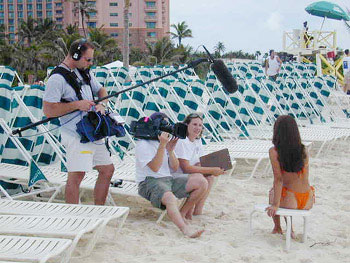
JP: I’d like to get back to the idea of the story, but first, do you feel like there is a specific aesthetic or look that you go for? If you’re all segment producers I imagine there has to be some sort of consistency, so do you all talk about it, or…?
MRM: When I first started, we did NFL Films Presents and we did Inside the NFL, and those were our two big shows. Even when I started in 1998, historically, those were the shows. Inside the NFL is the symphonic music, and there’s a style to it, it’s the witticisms and the metaphors about football, and we used Harry Kalas who just passed away last week. But his voice was signature to that show, and that show had a very, and still does even though it switched from HBO to Showtime this year, that has a style. You know what style it is. When you’re a segment producer on Inside the NFL, you know how you have to write, there is a style of writing, it’s the NFL Films style. The frozen tundra they always say, and then NFL Films Presents is the same thing, so it’s dramatic and NFL Films Presents is a little bit different.
Yes, of course NFL Films has a signature style – the symphonic music, Jon Facenda’s booming voice poetically recapping a game, our super slow motion shots of a guy running right at the camera or the extreme close up on the spiral – these will always be what people call to mind when they hear “NFL Films.” But you don’t want to serve filet mignon every night for dinner! And frankly, our kitchen has gotten a lot bigger, so we’ve got a lot more options—that’s a good thing for us. We’ve grown right along with the league and not every game or story or feature calls for that style. I do like to think that all NFL Films productions have a higher level of quality and production value because we all start with that style as our foundation, and not to sound like a sports TV snob, but maybe it’s just more of a “high brow” way of approaching football.
Now, we do so many different things, we do Hey Rookie for ESPN and we did Under the Helmet and we do Top 10 and we do… I don’t even know all the shows that we do. We do Greatest Games, so for every show, sure, we have a creative meeting at the beginning and talk about the style of the show. I would say those two shows [NFL Films Presents and Inside the NFL] are signature NFL Films and the other things that we do, you might not necessarily know anymore that they’re NFL Films, as sad as that sounds.
JP: Because you’re trying to fit into other…
MRM: Yeah, I mean Under the Helmet, and I just use that because that’s what I know and I did that for so long. That was a totally different style of writing. It was a fast-paced kids show on Fox that used popular music and did off-the-field features of the leagues’ hottest players of the moment. Sure, we are known for our passion for the history of football and the classic stories, but this show was all current. So, it was like, “Coming up, check out our new music video” [laughs], or we have Run DMC so you can’t do the long dramatic on the frozen tundra of Lambeau Field kind of scripts in that style of show. So, I don’t know if it’s a bad thing, but I don’t think I’m answering your question...
JP: No, it actually kind of gets us back to the story issue again because you mentioned how you’re interested in the struggle and not the strategy of the game. I was wondering, if you’re going into this looking for a story, how does that change the way you approach this game or the way that you put together what you put together? Are you looking for more personal interest things that you can then relate to the game, or is it stories within the game?
MRM: It’s a little bit of both. I’m going to use Inside the NFL again because that’s kind of our flagship show you could say. You look for what the big plays were, and then you cross your fingers that we have a good shot of it, and then maybe you’ll find some really neat rack from a football to a certain player with a really sad look on his face, and you’re like, “I gotta use that shot.” I personally find the visuals and try to marry them to a story. I let the visuals tell the story, and that’s one thing that’s different for us, when you go to shoot a film you storyboard it out ahead of time. We’re documentary, so I’m looking for the best visuals and hopefully the best big plays. Even though we focus on the story, NFL Films can’t say, “Well, we didn’t get a good shot of that amazing, one handed catch touchdown, so we just ignored it.” You can’t use that as far as what happened in the game, but you also have to slant it. A lot of times when we’re doing things for teams, when I do a Packers highlight film, you talk about how the Green Bay Packers fell for the first time, unfortunately, and you talk about their passion and their growth, and they sucked last year, their lessons learned and they’re a team for tomorrow, and they didn’t make history in 2008, but they’ll be back in 2009…
Because we do so many different shows, when I talk about approaching Inside the NFL, we’re cutting that game, we’re looking for the story, and we’re dramatizing whatever happened in the game. When we go out and shoot things for a story, I’m just using the Jake Plummer thing as an example, when I go out there to shoot that, I’m going to have a whole shot list that I’m going to sit down and direct, and say, “Hey, Jake stand next to that cactus with your helmet on and I’m going to pan down from the sky, and do a slow motion shot of you and then I’m going to shoot from four frames per second a crazy POV of the bike on the ground level.” So, it depends on what we’re shooting. When we do the features, the off the field stuff, it’s totally different than when we’re doing game recaps.
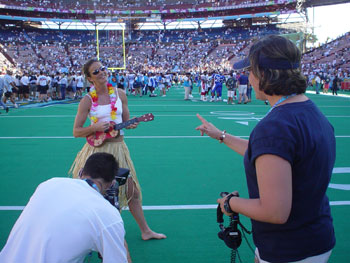
JP: There was another quote on “The Buzz” from USA Today, where it said, “NFL Films has done more than any sport to preserve the early images and sounds of its game.” NFL Films must have a tremendous archive, so do you allow access to people not associated with NFL Films to use the footage in your archive?
MRM: No, we don’t allow just anyone to use it. We have contracts in place with different networks that they can use our footage, but we actually have a department who is always looking for people who are the cheaters, we call them, catch the cheaters. And people will use our footage without paying for it, so they do have to pay for it. There is a rights issue there, and we have a whole accounting and licensing department that deals with that.
JP: I also read in the New York Times that at one point all NFL Footage belonged to the networks who originally broadcast it, but that it changed in the last few years so that the league owns it all. Do you know if that’s true? Because I would imagine that if it belonged to the networks then you guys couldn’t even use it…
MRM: It’s a tricky question, and I’m not an expert on it at all, because I get assigned a show and I just deal with creative, and we have whole legal departments who deal with that kind of stuff. I know that when I shot things, when I did Under the Helmet, it was a show for Fox so that footage that we were shooting, was basically owned by Fox, so different people who hire us to shoot things, they own it because they’re paying for the show, but the games are owned by the NFL… and then we sell it. That’s another way we make money is through those contracts that I know nothing about [laughs].
JP: When did the NFL Network and NFL.com start and what is the relationship between NFL Films, NFL Network, and NFL.com?
MRM: NFL Network started in November 2003, and is based out of LA. We provide them with programming, and they have their flagship show, Total Access. They’re under the NFL Media umbrella, as are we, but we're different branches of the same arm. It’s the same with NFL.com. We bid jobs to them just like we do to any other network. At this point, right now, they’re the same as when we do a show for ESPN.
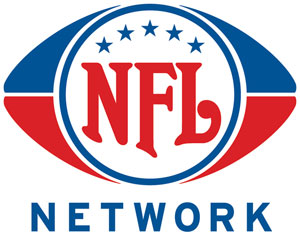
JP: An article in Sports Illustrated talked about the NFL moving its allegiance from NFL Films to the NFL Network and NFL.com. Do you think that is true?
MRM: I don’t think that the allegiance has gone from the league to the network at all. I don’t think that’s true at all. I think people respect NFL Films, we’ve been doing quality and artistic filmmaking for a lot of years…the NFL Network is definitely a television network operating as such, and we operate more like a film production company.
JP: What is the relationship between NFL Films and fans or audiences? Do you get any feedback from audiences or do you look at ratings?
MRM: You know, it’s funny, we never even worried about ratings because NFL Films has always had more of a romantic relationship with football fans. They go, “Oh! We love NFL Films!” They might not even know what shows we do, but again, they know that the slow motion and the certain style of music and the certain style of writing that we do, they know that that’s us and they go, “Oh! We love you guys!” So, our NFL Films Presents show that airs at 2AM on ESPN, that has no ratings, but we’re never going to stop doing that show ever, and people when they see it they go, “Oh! We love that show!”
The best way that I can sum it up is there was a player in one of Spike Lee’s movies a few years ago, and I was up at a red carpet event shooting it, and I was interviewing Philip Seymour Hoffman about working with the NFL player and there was a line of people along the red carpet, different New York television stations and newspapers, what have you, and in front of me there was a sign that said, “NFL Films,” and Philip Seymour Hoffman came up to me first, and he said, “Oh, my gosh, you work for NFL Films? That’s awesome! That’s such a cool job! You’re so lucky! That’s so cool!” and I was like, “Oh my word, are you kidding me with this?” But I’m saying that’s sort of the relationship, we’re known for being passionate about football and passionate about telling the stories of the games and I think that’s how the fans look at NFL Films too, they’re passionate about us. They are.
JP: Football and the NFL are very male dominated, and I imagine NFL Films would be male dominated too, so can you talk about your experience working as a female in a male dominated industry?
MRM: It is very much male dominated. In my department, the producer department at NFL Films, there are probably sixty some producers and there are five women and I’m the most senior woman and the only female senior producer, and it’s a little like working in a fraternity, especially in the beginning, and it’s changed a lot for the better even in the eleven years that I’ve been here. While it was difficult to be a “trailblazer,” frankly, I wasn’t expecting to deal with a frat-boy atmosphere in 1998, it has been awesome to see a “boys club” evolve. Now, we have some very successful women here and younger female producers. It’s not corporate (thank goodness!), but it’s comfortable.
Yes, it can be very difficult at times, but at the same time, it’s just natural that women are not going to be as drawn to football as men are, but I looked at it when I started working here as, “I don’t care if it’s football or wrestling or sailing or gymnastics, it’s filmmaking,” and so I looked at it that way. This has been an incredible place to grow as a filmmaker telling these stories, whether it’s about a game or a player overcoming cancer or wake-boarding in the offseason. I wish more women in film would pursue sports production. I think the female perspective is both valuable and necessary. And by “female perspective,” I don’t mean the touchy-feely Lifetime-for-Women stories! My perspective and style comes as much from not having grown up a football fan as from being a woman, and that’s just the sort of diversification that can keep shows and segments fresh. We used to do these shows for Lifetime, and I shied away from them because I was like, “I don’t need to work on a Lifetime show just because I’m a female here.”
JP: What shows did you do for Lifetime?
MRM: We used to do a show for Lifetime called NFL for Her, and Her Story, and we’d do features on players’ lives and their mothers. But at the same time, there is a female fan base in the NFL, there are female football fans, but it’s a bunch of dudes hitting each other though, so, yeah, it is a male dominated company and a male dominated sport. I’ve found that in some ways though, when I’ve done shoots with players and interviewed players, I feel like [being female] can be beneficial, and I don’t mean that I’m batting my eyelashes at them, I mean that they’re not intimidated by me. I’m not trying to dissect their play on the field, and I don’t think they think that I am doing that. I just want to talk to you about whatever subject I want to talk to you about, instead of grilling them about how many sacks they made in the game last night. I can approach it more on a humanistic level than a guy, and sometimes certain guys go and they’re almost enthralled with the player so much, and I could care less because I’m not really a football fan and I’m not intimidated by these guys.
JP: What do you see as your future with NFL Films?
MRM: Right now, I am just happy to be working somewhere that still shoots film and still has a bit of the “family company” vibe. I’ve got pez dispensers and little football-player bobble heads, leftover from the Under the Helmet studio days, on my office shelf and I don’t have to get dressed up like a banker to come to work. That’s a good feeling. As far as the future here, I mean, I’ve reached the senior producer level so now it’s just about having fun with the creative process and being challenged with new shows and becoming even more efficient—closer to where your first cut is almost your last cut, that sort of thing. Surprisingly, the work doesn’t seem to get “old.” Every story is different and with each new project, I can work on telling the story even better, whether it’s through music, writing, or editing. I feel pretty darn lucky to be able to work in film and television production which is what I went to school for and to love my “work”…even if it is football! Hahaha – just jokin’.

"This is what's really cool about NFL Films": An Interview with Margaret Ruffing Morris by Jennifer Porst is licensed under a Creative Commons Attribution-Noncommercial-No Derivative Works 3.0 United States License.

